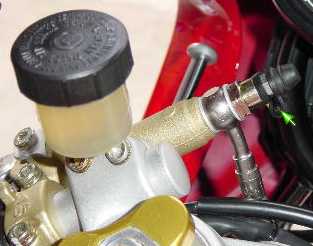If you are unable to engage neutral the most likely cause is air in the clutch hydraulic line. A trapped air bubble can compress (the fluid can't) so you won’t get a full stroke of the clutch pushrod and the clutch doesn’t fully disengage. Another common reason that the clutch won't completely disengage is that the aftermarket force-reduction slave units (and later model Ducati slave units) move the clutch pushrod less distance - a design trade-off to accomplish a reduction in clutch lever forces.
Air bubbles rise to the highest point in a hydraulic system so that's where bleed nipples belong and are usually placed. In Ducati superbikes the bleed nipple is placed at the lowest point in the system (duh) so the only way you can bleed all the air out is for the bubbles to be carried along with the fluid as you bleed, and bleed, and bleed the system. It is possible to bleed the system without using a bleed nipple at the master cylinder, but it takes a lot more work.
So, the Ducati clutch line is notoriously difficult to bleed using just the nipple at the clutch slave cylinder. Evoluzione and Yoyodyne, two aftermarket manufacturers of slave cylinders, encountered customer bleeding problem complaints so began selling a banjo fitting having a bleed nipple for use at the highest point in the hydraulic system. It works.
Here’s what it looks like:

However, you don't necessarily need one. You can try just loosening the bolt slightly and bleed with the regular banjo bolt as if it were a bleeder type. Careful though, any sprayed hydraulic fluid will damage painted surfaces.
Another reason why the clutch won't completely disengage is that any aftermarket force-reduction slave units (and later model Ducati slave units) move the clutch pushrod LESS DISTANCE - a design tradeoff to accomplish a reduction in clutch lever forces.
In other words you're pushing the clutch pushrod with a smaller hydraulic pressure applied over a larger slave piston area that gives you the same force needed to stretch the clutch springs. It just doesn't move as FAR.
The higher the force-reduction percentage (i.e. the larger the diameter of the slave cylinder), the less the clutch pushrod is moved, and the more likely that your clutch will not fully disengage.
If you have one, changing an adjustable clutch lever's engagement point (between the 4 and 1 lever positions ) has the effect of moving the slave cylinder the additional 1+ mm you need, right away.